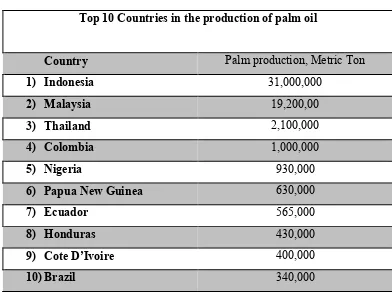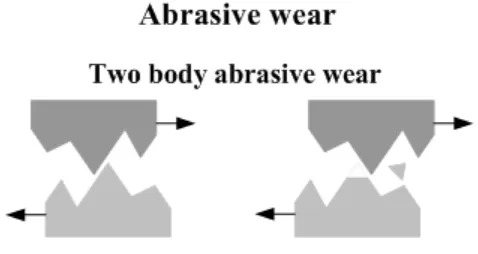EFFECT OF SURFACE ROUGHNESS ON TRIBOLOGICAL PROPERTIES OF PKAC-E COMPOSITE
AHMAD FARID BIN ZAINI
SUPERVISOR DECLARATION
“I hereby declare that I have read this thesis and in my opinion this thesis is sufficient in terms of scope and quality for the award of the degree of
Bachelor of Mechanical Engineering (Automotive) with Hons”
Signature: ...
EFFECT OF SURFACE ROUGHNESS ON TRIBOLOGICAL PROPERTIES OF PKAC-E COMPOSITE
AHMAD FARID BIN ZAINI
Laporan ini dikemukakan sebagai
memenuhi sebahagian daripada syarat penganugerahan
Ijazah Sarjana Muda Kejuruteraan Mekanikal (Automotif) Dengan Kepujian
Fakulti Kejuruteraan Mekanikal Universiti Teknikal Malaysia Melaka
DECLARATION
“I hereby declare that the work in this thesis is my own except for summaries and quotations which have been duly acknowledged”
Signature: ………. Author: AHMAD FARID BIN ZAINI
iii
DEDICATION
This thesis is special for
Dearest Dad and Mom
ACKNOWLEDGEMENT
In the name of Allah the Most Gracious, Most Merciful
Alhamdulillah, a very huge thanks for Allah, for he has guide me in choosing this project entitle “ Effect of surface roughness on tribological properties of PKAC-E composite”. He has also given me the strength and health to do this project from the start to the end. By putting my trust on him that I have gotten the courage and ideas to finnish this thesis.
I would also like to express my sincere gratitude and special thanks to my supervisor Dr Mohd Fadzli Bin Abdollah for he has guide me and encourage me through out the project. Not to forget to my co supervisor Dr Nor Azmmi Bin Masripan for his valuable advice on completing my thesis. Also thanks to the Master student, Ms. Ayuma for her kindness to guide me during the lab session.
v
ABSTRAK
ABSTRACT
vii
TABLE OF CONTENT
CHAPTER TOPIC PAGE
DECLARATION ii
DEDICATION iii
ACKNOWLEDGEMENT iv
ABSTRAK v
ABSTRACT vi
TABLE OF CONTENT vii
LIST OF TABLE ix
LIST OF FIGURE x
LIST OF SYMBOL xii
CHAPTER 1 INTRODUCTION 1
1.1 BACKGROUND 1
1.2 PROBLEM STATEMENT 2
1.3 OBJECTIVE 2
1.4 SCOPE OF STUDY 3
CHAPTER 2 LITERATURE REVIEW 4
2.1 Solid Lubrication 4
CHAPTER TOPIC PAGE
2.2 Oil Palm Kernel 5
2.3 Wear In Solid Materials 6
2.4 Wear Rate 8
2.5 Factor Affecting Wear Rate 9
2.5.1 Normal Load 9
2.5.2 Sliding Speed 10
2.5.3 Surface Roughness 11 2.6 Friction Force Between Two Colliding Surface 12 2.6.1 Coefficient Of Friction 13
2.7 Wear Test 15
2.7.1 Pin-On-Disc Wear Test 15
CHAPTER 3 METHODOLOGY 17
3.1 Background 17
3.2 Methodology Flow Chart 17 3.3 Determine The Composite Composisition Ratio 19
3.4 Mold Preparation 19
3.5 Specimen Preparation 21 3.5.1 Surface Roughness 22 3.5.2 Disc Surface Grinding 22
3.6 Tribology Test 23
CHAPTER 4 RESULT AND DISCUSSION 27
4.1 Result And Discussion 27 4.1.1 Physical Properties Of PKAC-E Specimen And
Pin On Disc Test Parameter
27
4.1.2 Effect Of Friction Force And Coefficient Of Friction On Surface Roughness
ix
CHAPTER TOPIC PAGE
4.1.3 Effect Of Specific Wear Rate On Surface Roughness
30
4.2 Surface Morphology Analysis Of PKAC-E Specimen
31
CHAPTER 5 CONCLUSION 33
5.1 CONCLUSION 33
5.2 RECOMMENDATION 33
REFERENCE 34
LIST OF TABLE
NO. TITLE PAGE
2.1 Palm Oil Production In The World 5
3.1 Table Of Wear Calculation 25
4.1 Physical Properties Of Pkac-E Specimen 27
4.2 Pin-On-Disc Test Parameter 28
xi
LIST OF FIGURE
NO. TITLE PAGE
2.1 Graphite Structure ( Source: http://www.subtech.com ) 5
2.2 Palm Kernel Shell (Source From http://envirocarbon.com.my) 6
2.3 Palm Shell Charcoal
(Source From http://envirocarbon.com.my)
6
2.4 Mechanism of abrasive wear between two body (source http://www.subtech.com)
7
2.5 Mechanism of Adhesive Wear
(source http://www.subtech.com)
7
2.6 Mechanism of Fatigue wear (source http://www.subtech.com)
8
2.7 Variation of wear rate, (mg/sec) to normal load, (N) of
aluminum disc on stainless steel pin.
9
2.8 Micrograph Of Top View Of Typical Worn Surface Of
Sample Containing Al/ 10wt.% PSAC
10
2.9 Graph of Friction of coefficient against sliding speed 10
2.10 3D and 2D profile of steel plates that are (a) unidirectional ground, (b) 8-ground and (c) randomly polished.
12
2.11 Variation of friction coefficient to the variation of normal load for different pair of material (sliding velocity : 1 m/s, relative humidity: 70%)
NO TITLE PAGE
2.12 variation of friction coefficient with the variation of duration of rubbing and normal load ( sliding velocity: 1m/s; relative humidity: 70%; aluminum-cooper pair)
15
2.13 Block diagram of pin on disc machine (Source:Chowdhury et al. 2011)
16
3.1 Methodological flowchart 18
3.2 a) Fine Powder PKAC, b) Hardener c) Resin 19
3.3 a) Mold Push Pin, b) Mold Top Plug, c) Mold Bottom Plug
d) Mold Body
20
3.4 Wax Applied To The Mold
( Source http://www.meguiars.com.au)
20
3.5 Motorize Hydraulic Molding Test Machine 21
3.6 Sample PKAC-E Specimen 22
3.7 Surface Grinding Machine 23
3.8 Pin-On- Disc Experiment Set Up 24
3.9 Electronic Densimeter 24
4.1 Graph of Friction force against surface roughness 28
4.2 Graph of average Coefficient of friction against Surface roughness
29
xiii
LIST OF SYMBOL
Vi = Wear Volume, m3 F = FN = W = Normal Load, N S = L = Sliding Distance, m
ki = K = Specific Wear Rate Coefficient, m2/N or m3/Nm Ff = Frictional Force, N
CHAPTER 1
INTRODUCTION
1.1 BACKGROUND
Composite material fabrications have been one of the most rapidly growing industries. Many type of composite material can be made to increase the physical properties of an original material, thus allowing each material to have its own special characteristic. In the field of tribology study, different situation call for different measure. For example, some material needed a high coefficient of friction properties to work (e.g , Break shoe) while other material needed material with low coefficient of friction (e g, piston cylinder).
Carbon fiber reinforced carbon- matrix composite is among the most study field in material engineering. Their properties of high- tensile strength is the most look characteristic, In the material manufacturing field. Moreover, this kind of composite is known to have high thermal conductivities and low coefficient of friction. Therefore, even if the material is relatively pricy, it is an opportunity for engineer to discover more about this composite material as it is a promising field.
2
1.2 PROBLEM STATEMENT
Palm tree is planted at large scale in Malaysia and having production life spend of up to 20 to 30 years before it need to be cut down. However, after the processes the stalk is being left to rotten. For quite some time, researchers have testing different kind of solid lubricant material to reinforce and coating material for tribological application. (Erdemir et al., 2000; Heimberg et al., 2001; Tokoroyama et al., 2006; Liu et al., 2009; Baradeswaran, 2011; Abdollah et al., 2012; Masripan et al., 2013). By burning the palm kernel, activated carbon material can be produce, a type of carbon that has self lubricating properties. This experiment is done to understand the effect of surface roughness of the material to the wear rate and coefficient of friction of the PKAC-E material under un-lubricated condition.
1.3 OBJECTIVE
The study is done to fulfill the objective which is:
1) To study the Palm Kernel Activated Carbon material as a possible dry lubricant. 2) To investigate the effect of surface roughness on friction and ware behaviors of
1.4 SCOPE OF STUDY
1) Using Palm Kernel activated carbon - mix with epoxy (PKAC-E) as material of the specimen.
2) Two parameter that need to be observe is wear rate and friction of coefficient. 3) Both parameters is to be investigate under different surface roughness of
material PKAC-E.
4) The PKAC-E specimen form to cylindrical shape using compacting method. 5) Experiment on tribology behavior of the material is conduct using Pin-on-disc
4
CHAPTER 2
LITERATURE REVIEW
2.1 SOLID LUBRICATION
Solid lubrication or dry lubrication is a lubrication obtained from material that is in a solid form. Despite it being in the solid form it has the ability to reduce the coefficient of friction and ware between two moving surfaces of material. Commonly used in the form of powder or a thin layer of film. This lubrication was able to slides in-between two colliding surface without the need of liquid as a medium. Dry lubricant often used on the application at a higher temperature at which liquid lubricant unable to operate perfectly (Lancaster,1973).
There were four most common solid lubricants in use which were graphite, molybdenum disulfide (MoS2), Hexagonal boron nitride, and tungsten disulfide. Each lubricant operates on different functions. The most commonly used is graphite and Molybdenum Disulfide (MoS2).
Graphite is a polycyclic carbon atom plane composed to each other and in hexagonal orientation.
Figure 2.1 : Graphite structure ( source http://www.subtech.com )
2.1.1 Aplication of Dry Lubricant on Material
6
2.2 OIL PALM KERNEL
[image:21.595.121.513.225.518.2]Oil palm is a worldwide industry which being produce in 42 countries. Covering around 27 million acres. For each acre it is estimated that average of 10,000 lbs/ acre. The industry is expanding vastly over the past few decades.
Table 2.1: Palm Oil production in the world Top 10 Countries in the production of palm oil
Country Palm production, Metric Ton
1) Indonesia 31,000,000
2) Malaysia 19,200,00
3) Thailand 2,100,000
4) Colombia 1,000,000
5) Nigeria 930,000
6) Papua New Guinea 630,000
7) Ecuador 565,000
8) Honduras 430,000
9) Cote D’Ivoire 400,000
10) Brazil 340,000
Figure 2.2: Palm Kernel Shell (source from http://envirocarbon.com.my)
Figure 2.3: Palm Shell Charcoal (source from http://envirocarbon.com.my)
2.3 WEAR IN SOLID MATERIALS
8
[image:23.595.198.438.288.363.2]Figure 2.4: Mechanism of abrasive wear between two body (source http://www.subtech.com)
Figure 2.5: Mechanism of Adhesive Wear (source http://www.subtech.com)
All the type of wear will cause one of two results: (i) the constant friction between two surfaces will produce a thin layer on the surface area in contact which will break off, producing debris; (ii) the thin layer could also fracture thus producing flake like debris.
In the first result, when two surfaces is in contact due to application of motion, the asperity junction (the real surface area on contact) has a concentrated loading on each of its peak, this will result in increasing stress thus inducing plastic deformation on the area, upon several repeated sliding the bond between asperity would break of into small debris.
2.4 WEAR RATE
Even though wear mechanism is inevitable between two colliding material, there were ways to reduce it effect by controlling the wear rate. Wear rate can be defined as the rate of wear of a material on an applied load for a certain distance (Archard’s wear equation).
� = ����
Where:
Vi = Wear volume, m3 F = normal load, N s = sliding distance, m

